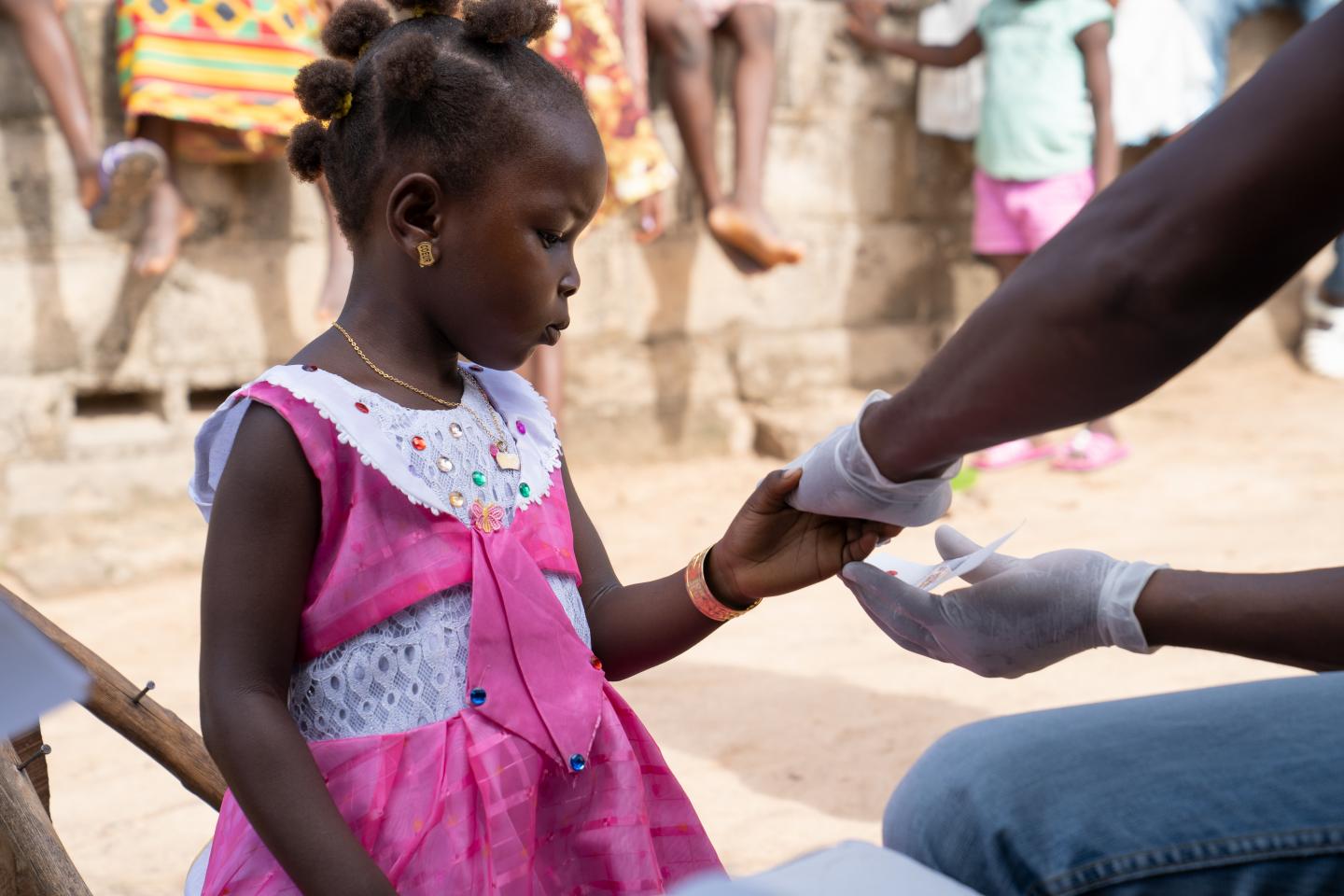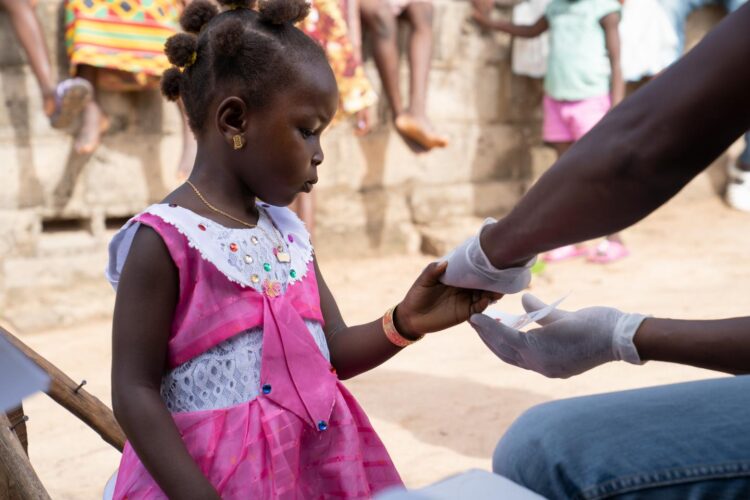
Credit: Daniel Lesher, Penn State
UNIVERSITY PARK, Pa. — A new type of housing modification can reduce malaria incidence among children by around 40-50%, according to an international team of researchers. The intervention uses window screening, together with PVC tubes fitted with insecticide-laced screens and installed under the eaves of homes, as a novel method of killing malaria mosquitoes as they attempt to enter the house. By combining a physical barrier plus an insecticide, the housing modification both blocks and kills mosquitoes, thereby protecting not only the people living inside, but also the community at-large. The findings appear today (Feb. 25) in The Lancet.
“Eighty percent of malaria transmission happens at night when people are in their homes,” said Matthew Thomas, an academic affiliate in entomology at Penn State, who led the research. “Insecticide-treated bed nets have been shown to reduce malaria and are probably one of the most important public health tools in sub-Saharan Africa. But they need to be replaced every three years and many people don’t have access to them, or don’t use them properly. In this study, we essentially elevated the concept of an insecticide-treated bed net to the level of the house. We demonstrate that turning the house itself into a ‘lure and kill’ device significantly reduces incidence of malaria infection among children, even in areas where malaria-carrying mosquitoes are highly resistant to the insecticides that are most commonly used on bed nets.”
Thomas, also the director of the York Environmental Sustainability Institute at the University of York, and his colleagues evaluated a type of lethal house lure in which screening was added to windows and doors, and pieces of PVC pipe (typically 8-10 per house) were inserted into the eaves of the house where the wall joins the roof. These ventilation tubes were, in turn, fitted with screened inserts laced with insecticides, creating a novel targeted insecticide delivery system called the In2Care® EaveTube. The team’s goal was to determine if this combination of screening plus EaveTubes (referred to as, SET) would reduce exposure to malaria mosquitoes and, thereby, reduce clinical malaria incidence over two years in children ages 6 months to 10 years living in central Côte d’Ivoire.
“Malaria is the leading cause of death among children under five years of age and of pregnant women in Côte d’Ivoire,” said co-author Raphael N’Guessan, a medical entomologist at the London School of Hygiene & Tropical Medicine with an affiliation at Institut Pierre Richet in Bouaké, Côte d’Ivoire, whose family home lies within one of the villages that the team studied. “For example, diagnostic tests conducted in random subsets of children before we began the trial indicated that in some of the study villages more than 90% had signs of malaria parasite infection, though many without symptoms. The lowest rate of infection we observed in a single village was about 45%.”
The project’s study area included 40 villages in central Côte d’Ivoire. Twenty of the villages were part of the treatment arm in which all eligible households were offered SET. The other 20 villages were used as the control arm and received no house modification. Households in both study arms were offered insecticide-treated bed nets as a baseline intervention.
“Many traditional house designs in Africa have open eaves, and studies have shown that closing the eaves can reduce indoor mosquito abundance, yet it also decreases household ventilation,” said Eleanore Sternberg, a research associate at Penn State while the study was conducted and now a program manager at the Liverpool School of Tropical Medicine. “The EaveTube design blocks mosquitoes from entering, but still allows for air to pass through.”
Sternberg, one of the lead authors on the paper, explained that each tube contains a removable insecticide-treated screened insert with electrostatically charged netting that can hold powder formulations of insecticides. The team used the pyrethroid insecticide beta-cyfluthrin in its study.
“Mosquitoes are drawn into the EaveTubes by heat and odor cues emanating from the occupants inside the house,” she said, “and even brief contact with the insecticide-treated insert can result in death.”
She added that a benefit to placing insecticides in tubes in the eaves of the house is that it removes the insecticides from the proximity of the householders.
The researchers measured the epidemiological impact of SET by regular screening for malaria in a cohort of 50 randomly selected children in each of the villages, for a total of 1,300 and 1,260 children in the control and intervention arms, respectively. At the initial enrollment visit, all cohort children received a three-day course of an antimalarial medicine to clear any existing malaria parasite infection. A second round of parasite clearance took place one year later. If at any point during the study, a child tested positive for malaria, he or she was treated with an antimalarial medicine.
“We found an overall reduction in incidence of clinical malaria of 38% in the intervention arm, and in villages where SET coverage was above 70% (13 out of the 20 in the intervention arm), risk of malaria infection was 47% lower than in control village clusters,” said Jackie Cook, associate professor of epidemiology at the London School of Hygiene & Tropical Medicine and the other lead author on the paper. “Even in villages with less than 70% coverage, there still appeared to be some benefit compared to control villages.”
The team measured the entomological impact of SET using a protocol, called Human Landing Catches, in which volunteers sat with their legs uncovered, trapping any mosquitoes that landed on their legs in glass tubes plugged with cotton. Captures were done indoors and outdoors in a subset of randomly selected houses in each village across the two years of the study, yielding hundreds of thousands of mosquitoes. Technicians brought the mosquitoes back to the laboratory to identify the species and inspect the mosquitoes for the presence of malaria parasites.
“We found that mean indoor mosquito density was substantially reduced in the intervention arm compared to the control arm,” said Thomas. “In addition, there was some evidence of a reduction in mean outdoor mosquito density. Reducing the density of infectious mosquitoes is important for reducing malaria transmission. With SET, not only do people within the house gain some protection, but because you’ve killed the mosquitoes that enter the tubes, they can’t then go on to bite your neighbor. So, you get two actions: you get personal protection, and you get community protection.”
At the end of the trial, the researchers conducted a cost-effectiveness analysis to measure the incremental economic and financial cost per malaria case averted by the SET intervention compared to the control arm.
“Rapid economic and population growth in sub-Saharan Africa means that millions of new houses will be built in the coming decades and millions more existing houses are being retrofitted with new roofs and other features,” said Eve Worrall, health economist and senior lecturer at the Liverpool School of Tropical Medicine. “Our economic analysis suggests SET is an attractive option for improving population health in Côte d’Ivoire and is similar in cost-effectiveness to other core vector control interventions used across sub-Saharan Africa.”
Sternberg, who managed the project and lived in Côte d’Ivoire for the duration, said that the multidisciplinary project, comprising epidemiologists, entomologists, social scientists and economists, would not have been possible without the efforts of around 50 Ivorian project staff — including scientists, technicians, medical personnel and even drivers — and nearly 900 volunteers from the study villages.
“This project was an opportunity to interact with some extraordinary people to do something that we hope will make a difference in the world,” she said. “That’s why we did the work.”
###
Other authors on the paper include Ludovic P. Ahoua Alou, Serge Brice Assi, Alphonsine A. Koffi, Carine J. Aoura, Rosine Z. Wolie, Bouaké, Côte d’Ivoire. Rosine Z. Wolie is also affiliated with the Université Felix Houphouët Boigny, Abidjan, Côte d’Ivoire. Welbeck A. Oumbouke is with the Innovative Vector Control Consortium and is also affiliated with the London School of Hygiene and Tropical Medicine. Author Dimi T. Doudou is from the Université Alassane Ouattara, Bouaké, Côte d’Ivoire, and author Immo Kleinschmidt is affiliated with both the London School of Hygiene & Tropical Medicine and the University of the Witwatersrand, Johannesburg, South Africa.
In2Care is a private limited company registered and based in the Netherlands, founded and privately owned by a team of entrepreneurs with expertise in medical entomology, healthcare product development and marketing in developing countries.
This research was supported by the Bill & Melinda Gates Foundation with a grant to Penn State.
Media Contact
Sara LaJeunesse
[email protected]





